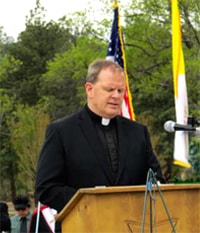 By Fr. Glenn Jones:
By Fr. Glenn Jones:
Let’s see … did anything notable happen this week? Hmmm … let’s think.
Ah, yes … the Dobbs v. Jackson Women’s Health/Roe v. Wade overturn by the Supreme Court—celebration for some, infuriating for others. But, no matter which side one falls on, we know one thing for certain: it is not the last we’ll hear of the debate; quite the contrary. Because of the extreme polarity of the division, it will be a battle that will likely go on—as it already has—for decades (centuries?) to come.
The Dobbs decision is an interesting (rather long) read as it goes through the reasoning of the court. We non-lawyers generally bleep though the very numerous case citations scattered throughout, but the text—like many SCOTUS decisions—is not written over-legalesed, making it pretty readable. Stare decisis is a term to look up prior to reviewing it, though; a principle cited throughout the decision.
Abortion is, of course, an intensely emotional topic for both sides—the rights of a woman balanced with the rights of the life developing within her. This latter issue cannot NOT be addressed as it is absolutely central—indeed, the raison d’être—of the anti-abortion position and cause, and thus cannot be unaddressed by the opposing side as it often is. Is the developing life within the woman a human being, or is it simply as a type of parasitic, tumorous growth which may be excised at any time prior to its emergence?
Assuming one believes the fetus “becomes” a human being at some point in gestation, at what point is that, with what criteria and why? Or does it progressively become a human being by degrees; if so, then by what degrees at which point in time, and why? (This is one of the main points that Justice Alito makes in Dobbs concerning the SCOTUS majority’s perceived weakness of Roe—that the Roe SCOTUS essentially tried not only to make that determination with neither basis nor authority, and de facto legislated it). Or is its status as human (or not) dependent upon the subjective judgment of its “host”—a “baby” for one mother, a non-human “growth” for another … perhaps even changing back and forth depending on the mother/host’s reasoning and desire at the time?
The anti-abortion side regularly takes the stance that becoming “human” begins at the event of greatest transformation which, of course, is at conception, each moment thereafter—even birth being comparatively small and incremental changes in development, location and sources of nutrition. And, they argue, if a pre-emergent “organism” is NOT actually a human being and may be aborted, how do we justify laws against destroying endangered species’ (eagle, condor, owl, etc.) eggs?—a rather tired example, yes, but it still seems relevant. Are increased/decreased rights and value of gestational life dependent upon population—less if there’s “lots more where they came from”?
Sadly, though, the violent intimidation tactics which have emerged—either just after Roe, and now after Dobbs—are indeed tragic, and certainly counter-productive when trying to convince the electorate toward one’s own position. After Roe was the scattered bombing of abortion providers; now is the attack on pro-life centers, and even attacking those centers’ advisees and patients—which makes no sense whatever if one is truly pro-“choice”. They normally simply provide information about pregnancy and fetal development—more information to make an informed choice.
How ironic that we lament historical events like the Nazi “Kristallnacht” against Jews, and yet never stop digressing to intimidation tactics—once again “justified” as they have been in the past by some in the political sphere because of supposed “righteous outrage”. Yet those who partake in violence in hope of furthering their causes thereby condone violence to further any cause, including their opponents’—with a “what goes around, comes around” perception. We might consider the violence sometimes accompanying the recent BLM movement: did it bring sides together, or did it just create more, and more deeply entrenched, resentment and division?
Is Dobbs a “war on women”, as politicians sometimes claim? It seems no, as women are more often than not leading the pro-life cause; in fact, many of the pictures of those celebrating Dobbs were mostly of women. One could ask, too, whether those who cite “war on women” will now define “woman”, for definition seems elusive in our day by many. Even the recent SCOTUS nominee and an increasing number of politicians seem to not be able to answer that question. So, how does one declare war on an undefined being? How would they know who to war against? If there is no solid definition of “woman” (OR “man” for that matter), then how can they know there’s a war against them?
Of course we’re being argumentative to make a point, but it does illustrate somewhat self-conflicting and increasingly confusing reasoning in our modern society.
We hope, regardless of “side” the reader is on, that this article at least provides a bit of food for thought. As we know, Dobbs does not outlaw abortion, but returns such decision back to the states’ electorates … for now. This, of course, will result in abortion provision/prohibition being a patchwork among the states, fluid as to whether it is allowed depending upon each election cycle. Legality of abortion will likely bounce back and forth between legal or not—and every degree in-between—for the foreseeable future. We pray that, whether or not protesters recognize the pre-born as human life or not, that they will refrain from physical harm against the post-born, who most certainly are.
Editor’s note: Rev. Glenn Jones is the Vicar General of the Archdiocese of Santa Fe and former pastor of Immaculate Heart of Mary Catholic Church in Los Alamos.

